NavSource Online: "Old Navy" Ship Photo Archive
USS Richmond (II)
Nan - Rush - Jig
Awards, Citations and Campaign Ribbons
Civil War Medal - World War I Victory Medal
Please report any broken links or trouble you might come across to the Webmaster. Please take a moment to let us know so that we can correct any problems and make your visit as enjoyable and as informative as possible.
| Click On Image For Full Size Image |
Size | Image Description | Contributed By |
|
|---|---|---|---|---|
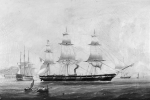
098605524 |
199k | Black and white photo of an oil painting by De Simone of USS Richmond at anchor, probably off Naples, in 1861, with a British Navy Ship-of-the-line at left.
U.S. Naval History and Heritage Command. Photo # KN-715, Collection of Vice Admiral Morton L. Deyo, USN (Ret), 1959. Note Mrs. Deyo donated this painting to the Navy Department in 1963. National Archives Curator Accession #: 63-353-A.. |
Robert Hurst | |
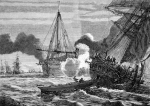 |
471k | Lithograph depicting the engagement of CSS Manassas and USS Richmond, 12 October 1861.
Richmond was rammed and seriously damaged. Manassas was also damaged, mainly by the force of her own ramming effort but was repaired.
Engraving from Le Monde Illustre, 1861. Courtesy of the Library of Congress. National Museum of the U.S. Navy |
Robert Hurst | |
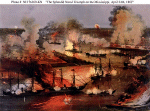 |
158k | Colored lithograph, published by Currier & Ives, 1862. The original print bears the following descriptive text: "Destruction of the Rebel gunboats, rams and iron clad batteries by the Union Fleet under Flag Officer Farragut. The attack was commenced on the 18th of April and continued until the 25th resulting in the capture of Forts Jackson, St. Phillip, Livingston, Pike and the city of New Orleans, as well as the destruction of all the enemy gunboats, rams, floating batteries (iron clad), fire rafts, booms and chains. The enemy with their own hands destroying cotton and shipping valued at from eight to ten millions of dollars. 'The sight of this night attack was awfully grand, the river was lit up with blazing rafts filled with pine knots and the ships seemed to be fighting literally amidst flames and smoke.'" In this view, ships are identified as (starting at top left center, up the river, running down to the right, then across toward the left): Confederate steamers; USS Cayuga (leading the Union column), USS Pensacola, burning confederate steamer, USS Varuna, USS Oneida, USS Mississippi (engaging the ram CSS Manassas), USS Richmond, USS Kineo, USS Hartford (flagship, in collision with a fire raft), USS Brooklyn and USS Winona. A Confederate fire raft is in the lower right. Fort St. Phillip is shown at right and Fort Jackson at left. Courtesy of the U.S. Navy Art Collection, Washington, D.C. |
Tommy Trampp | |

098605530 |
298k | USS Richmond crew was assembled the morning after that terrible night of fighting past Forts Jackson and St. Philip.
Richmond. was the third vessel in line in the center division led by Farragut himself. Only two of her crew were killed and four injured, for CDR.
Alden laid carefully prepared a splinter netting which caught the death-dealing pieces of plank and scantling, and prevented them from sweeping the gundeck.
Early in October,1861, Richmond, under CAPT. John Pope, led the blockading vessels up the delta of the Mississippi to the Head of the Passes, where the
stream broadens into a deep bay two miles wide, giving ample room for maneuvers
"The photographic history of the Civil War: thousands of scenes photographed 1861-65, with text by many special authorities". By Miller, Francis Trevelyan, 1877-1959 Lanier, Robert S. (Robert Sampson), 1880-. Pub. Review of Reviews Co. New York : 1 January 1911. |
Robert Hurst | |
 |
272k | USS Richmond at anchor in Baton Rouge, LA. in 1863. Library of Congress, Photo No. Lot 14043-2 No. 43 |
Mike Green | |

098605506 |
243k | Robert Weir who chronicled with pen and ink life on board USS Richmond, sent many of his sketches to Harper's Weekly where they were refined and published. A reversed rendering of his sketch (left) of the sloop off Mobile Bay appeared in the newspaper seen here as a woodcut engraving titled "The United States Sloop of War [USS] Richmond on Blockade Duty off Mobile.", published in "Harper's Weekly" February, 1864. | Tommy Trampp | |
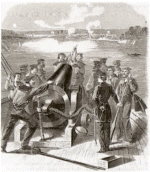 |
163k | Sketch of the USS Richmond 100 pounder Parrott gun crew serving the gun. Originally appeared on the cover of "Harper's Weekly" 18 July 1863. Sketched by an unknown naval officer. | Tommy Trampp | |
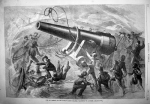 |
45k | USS Richmond 100 pounder Parrott gun causes havoc on deck after breaking loose during a storm in 1864.
"THE PET PARROTT OF THE UNITED STATES STEAMER “RICHMOND” IN A STORM" May 14, 1864 Harper’s Weekly |
Tommy Trampp | |
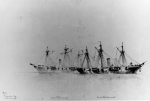 |
136k | USS Lackawanna and USS Richmond stripped for action, at Pensacola, Florida, on 3 August 1864, just prior to the Battle of Mobile Bay. .
US Naval History and Heritage Command photo # NH 51184. |
USNH&CC | |
 |
230k | Line engraving published in Harper's Weekly, 17 September 1864. Entitled "Admiral Farragut's Fleet Bombarding Fort Morgan, August 22, 1864",
it depicts from left to right); USS Lackawanna, USS Manhattan, USS Octorara, USS Brooklyn, USS Winnebago and USS Richmond. Fort Morgan is shown in the right center distance, and a battery is at the far left US Naval History and Heritage Command photo # NH 59150. |
US Naval History and Heritage Command | |
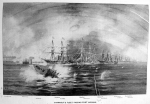 |
156k | Flag Officer Farragut ship's passing Fort Morgan during the Battle of Mobile Bay, 5 August 1864. Drawing from the book
"Under Both Flags" Veteran Publishing Co., © 1896. From left to right:
USS Manhattan USS Tecumseh USS Brooklyn USS Octorara USS Hartford USS Metacomet USS Richmond USS Port Royal USS Lackawanna USS Seminole USS Monongahela and USS Kennebec |
Tommy Trampp | |
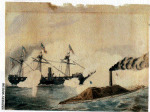
098605519 |
183k | A Robert Fulton Weir stetch of USS Richmond engaging CSS Tennessee during the Battle of Mobile Bay, 5 August 1864.
Mariner's Museum, Newport News, VA. |
Tommy Trampp | |
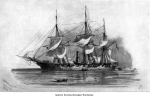 |
240k | Image of USS Richmond at Navy Yard Philadelphia, PA., (1872). Illustration from “Official Records of the Union and Confederate Navies in the War of the Rebellion” Series 1, Volume 18. |
Bill Gonyo | |
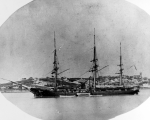
098605523 |
221k | USS Richmond at anchor off Mare Island Navy Yard, Vallejo, CA. date unknown.
US Naval History and Heritage Command photo # NH 63460 |
Mike Green | |
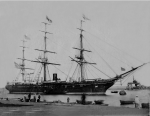 |
231k | USS Richmond at Port Said. after departing Norfolk 11 January 1879 while enroute to Yokohama via the Suez Canal. Photo by H. Arnoux. Photo from the collection of the late Antoni Blasi, with permission to publish them, by Camil Busquets.This photo, and several hundred more, can be found in Camil Basquets book "50 Años de Retrato Naval Militar (1870-1920)", ("50 Years of Naval Photography,") published in 2010. |
Col·lecció Antoni Blasi, via Camil Busquets and Fabio Peña | |
 |
139k | USS Richmond moored to a buoy, date and location unknown. Photo from "Warships of The Civil War Navies" by Paul H. Silverstone |
Robert Hurst | |
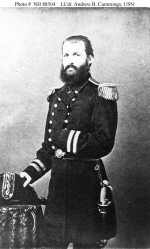 |
80k | Andrew Boyd Cummings joined the steam sloop USS Richmond during her 1860-1861 Mediterranean deployment. After Richmond returned to the United States in mid-1861 she, with Cummings as her First Lieutenant and Executive Officer, undertook active service against the Confederacy in the Gulf of Mexico, most notably the April 1862 capture of New Orleans and subsequent operations up the Mississippi River. Specifically commended for his performance, he was promoted to Lieutenant Commander in July 1862. Andrew Boyd Cummings was gravely wounded during Richmond's 14 March 1863 attempt to pass the batteries at Vicksburg, Mississippi and died four days later. | Bill Gonyo | |
 |
140k | "The Battle at the Southwest Pass -- The Ram 'Manassas' attacking the 'Richmond.' -- Sketched by an Officer of the 'Richmond'." A line engraving published in "Harper's Weekly", 1861, depicting CSS Manassas attacking USS Richmond near the Head of Passes, Mississippi River, on 12 October 1861. Other ships depicted include the U.S. sailing sloops of war USS Vincennes and USS Preble (in left center and at right). US Naval History and Heritage Command photo # NH 59012. |
Robert Hurst | |
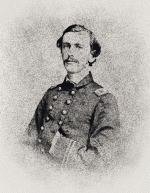 |
316k | Charles E. Emery who was a engineering officer in USS Richmond during the Civil War. | Charlie Glendinning for his Great-Grandfather Charles E. Emery | |
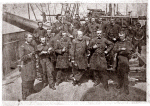 |
635k | USS Richmond officers during the Civil War. | Charlie Glendinning for his Great-Grandfather Charles E. Emery | |
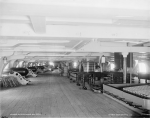 |
121k | USS Richmond gun deck, circa 1890-1901 | Library of Congress photo # 4a14697v Detroit Photographic Co. Collection | |
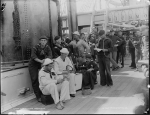 |
182k | USS Richmond sailors on deck, circa 1890-1901 | Library of Congress photo # 4a14698v Detroit Photographic Co. Collection | |
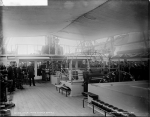 |
152k | USS Richmond church services, circa 1890-1901 | Library of Congress photo # 4a14699v Detroit Photographic Co. Collection | |
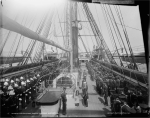 |
197k | USS Richmond , circa 1890-1901 | Library of Congress photo # 4a14700v Detroit Photographic Co. Collection | |
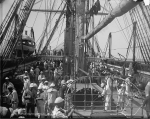 |
252k | USS Richmond polishing brass work, circa 1890-1901 | Library of Congress photo # 4a14701v Detroit Photographic Co. Collection | |
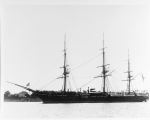
098605525 |
128k | USS Richmond at anchor, date and location unknown.
US Naval History and Heritage Command photo # NH 69794 |
Robert Hurst | |
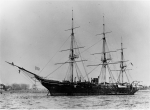
098605526 |
163k | USS Richmond at anchor, date and location unknown.
US Naval History and Heritage Command photo # NH 43579. |
Robert Hurst | |

098601211 |
66k | The masting shear crane is shown at the North end of Norfolk Navy Yard, Portsmouth, VA. A Civil War era monitor style ship is tied up along the
river berth, alongside the 1840 stone launching slip.
In the background are the Receiving Ships USS Richmond and USS Franklin, across the river at the Saint Helena Annex, the US Navy training ground.
Virginia shell series postcard #4, produced by the S. Langsdorf & CO. of New York. These cards were embossed and printed (lithographed) in Germany before World War I. |
Brian Baird | |

098601212 |
512k | The North end of Norfolk Navy Yard is in foreground; the US Navy Training Ground at Saint Helena, Berkley, Norfolk, VA, is across the Elizabeth River on right. Submarines and torpedo boats are berthed at its angled piers. Moored in the river are the receiving ships USS Franklin and USS Richmond, used to house sailors that were being trained at Saint Helenas. Two white hull pre-WWI battleships are berthed along the quay wall of the Navy Yard, one at Berth 1 (left) adjacent to the masting shear crane and the other at Berth 7 (right). In the center of the photo is Wetslip# 1, with four-stack cruiser (unidentified) at Berth 3. Undated circa 1908. | Brian Baird | |

098601213 |
115k | Panoramic photograph (cropped) looking north to the US Navy's Saint Helena Training Station in the Berkley section of Norfolk, VA.. On the
left, across the Elizabeth River, is the Norfolk Navy Yard. The ships shown in the middle of photo are the receiving ships USS Richmond
(left) and USS Franklin (right), at the St Helena Training Ground of the US Navy, circa 1913-1915.
Image by Harry Cowles Mann. Property of the Norfolk Public Library (Va.), Sargeant Memorial Collection. |
Brian Baird | |

098605527 |
72k | USS Richmond's Barge, "blueprint", 1 September 1888. Department of the Navy. Bureau of Construction and Repair
US National Archives Identifier (NAID) 109188763 |
Robert Hurst | |

098605528 |
88k | USS Richmond's Gig Whale Boat "as built abroad", "blueprint", 1 October 1884
US National Archives Identifier (NAID) 109188767. |
Robert Hurst | |

098605529 |
149k | USS Richmond's Steam Barge "blueprint", 1 September 1888. Department of the Navy. Bureau of Construction and Repair.
US National Archives Identifier (NAID) 109188765. |
Robert Hurst | |
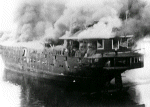 |
198k | Ex-USS Richmond at Eastport, Maine being burned for scrap in 1920. Captain Turner is on the stern hauling down his flag.
Note the boat standing by to rescue him. Franklin D. Roosevelt witnessed this event.
US Naval History and Heritage Command, Photo No. NH 44800. |
Mike Green | |
| Back To The Navsource Photo Archives Main Page | Back To The Old Navy" Steam and Sail Index |
| Comments, Suggestions, E-mail Webmaster. |
|
This page is created and maintained by Gary P. Priolo |